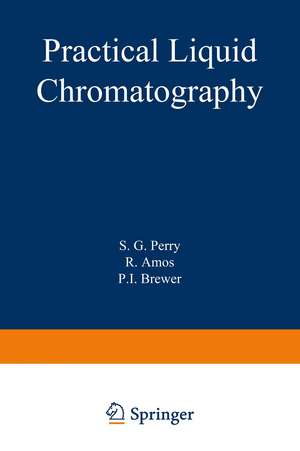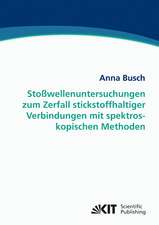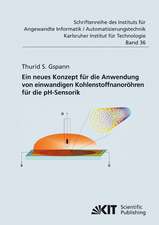Practical Liquid Chromatography
Autor S. Perryen Limba Engleză Paperback – 17 mar 2012
Preț: 384.70 lei
Nou
Puncte Express: 577
Preț estimativ în valută:
73.61€ • 78.72$ • 61.38£
73.61€ • 78.72$ • 61.38£
Carte tipărită la comandă
Livrare economică 17 aprilie-01 mai
Preluare comenzi: 021 569.72.76
Specificații
ISBN-13: 9781468419375
ISBN-10: 1468419374
Pagini: 248
Ilustrații: XIV, 230 p.
Dimensiuni: 152 x 229 x 13 mm
Greutate: 0.34 kg
Ediția:Softcover reprint of the original 1st ed. 1972
Editura: Springer Us
Colecția Springer
Locul publicării:New York, NY, United States
ISBN-10: 1468419374
Pagini: 248
Ilustrații: XIV, 230 p.
Dimensiuni: 152 x 229 x 13 mm
Greutate: 0.34 kg
Ediția:Softcover reprint of the original 1st ed. 1972
Editura: Springer Us
Colecția Springer
Locul publicării:New York, NY, United States
Public țintă
ResearchCuprins
1: Liquid Chromatography—The Background.- 1.1. Perspective.- 1.2. Plan of the Book.- 1.3. Chromatography and Its Basic Variants.- 1.4. Development Methods in Chromatography.- 1.5. Basic Experimental Arrangements.- 1.6. Measures of the Effectiveness of Chromatographic Separations.- 1.7. Retention Parameters.- References.- Further Reading.- 2: Band Spreading in Chromatography.- 2.1. Introduction.- 2.2. Factors Leading to Band Spreading.- 2.3. The “Random-Walk” Concept.- 2.4. Simple Mathematics of the Random Walk.- 2.5. Molecular Diffusion.- 2.6. Mass Transfer.- 2.7. Eddy Diffusion.- 2.8. Final Expression for Plate Height.- 2.9. Extrabed Contributions to Band Spreading.- 2.10. Columns versus Plates.- 2.11. Summary—Important Practical Consequences of Theory.- References.- Further Reading.- 3: Adsorption Chromatography: Mechanism and Materials.- 3.1. Introduction.- 3.2. Adsorption Isotherms.- 3.3. Nature of Adsorption Forces.- 3.4. Choice of Chromatographie System in LSAC.- 3.5. Variation of Adsorption Coefficient Kº with Solute Structure.- 3.6. Individual Adsorbents.- References.- Further Reading.- 4: Liquid Partition Chromatography—Mechanism and Materials.- 4.1. Introduction.- 4.2. Thermodynamics of Liquid-Liquid Partition.- 4.3. Selection of Phase Pairs.- 4.4. Support Materials.- 4.5. Further Practical Considerations.- References.- Further Reading.- 5: Exclusion Chromatography—Mechanism and Materials.- 5.1. Introduction.- 5.2. Peak Broadening in Exclusion Chromatography.- 5.3. Theories of Exclusion Chromatography.- 5.4. Stationary Phases for Exclusion Chromatography.- Appendix: Applications of Exclusion Chromatography.- References.- Further Reading.- 6: The Technique of Thin-Layer Chromatography.- 6.1. Introduction.- 6.2. Outline of Technique.- 6.3. TheStationary Phase.- 6.4. Preparation of TLC Plates.- 6.5. Application of the Sample.- 6.6. Choice of Mobile Phase.- 6.7. Development of Chromatogram.- 6.8. Reproducibility of RF Values.- 6.9. Detection of Solutes.- 6.10. Chromatographic Records.- 6.11. Direct Quantitative Analysis on the Layer.- 6.12. Removal of Solute from Adsorbent Layer.- 6.13. Use of Ancillary Techniques.- 6.14. Present Status and Future Outlook.- References.- Further Reading.- 7: Equipment for Column Chromatography.- 7.1. Introduction.- 7.2. Pneumatics.- 7.3. Gauges.- 7.4. Gradient Elution Supply.- 7.5. Sample Injectors.- 7.6. Columns and Fittings.- 7.7. Grinders and Sizing Equipment.- 7.8. Fraction Collectors.- 7.9. Detectors.- Appendix: A Short Guide to Commercial Equipment Suitable for Column Liquid Chromatography.- References.- Further Reading.- 8: Current Status of Liquid Chromatography: Place among Family of Chromatographic Techniques.- References.

























